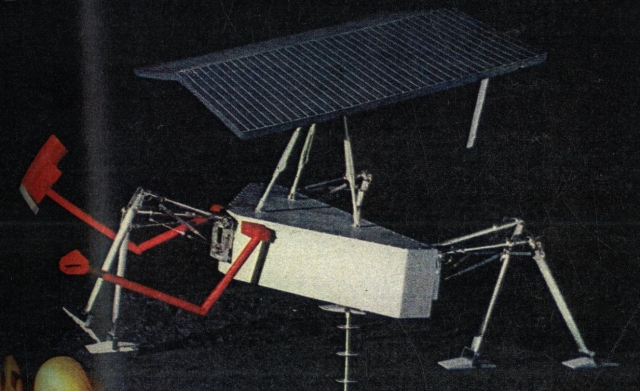 Реклама Google — средство выживания форумов :)
Реклама Google — средство выживания форумов :)
-
/M175252641LR_ap15.png)
Кто, кроме Ирана, способен отправить беспилотник с хорошей оптикой для разоблачения лунной аферы?
Какая страна может позволить себе подобную постановку задачи?Теги:
Напомню предыдущие попытки и чем они кончились.
26.11.2002 между российско-украинской компанией "Космотрас" и частной американской компанией "TransOrbital" был подписан контракт об использовании российско-украинских конверсионных ракет-носителей "Днепр" (СС-18 "Сатана") для реализации первой американской коммерческой программы полетов малых космических аппаратов к Луне. Предполагалось, что зонд "TrailBlazer" (запуск которого был намечен на июнь 2003 г., а потом перенесен на октябрь) произведет высококачественную видеосъемку Луны и позволит увидеть американские и советские аппараты, которые в свое время совершили посадку на Луну и остались там. Для получения разрешения на «лунную» коммерческую деятельность компании понадобилось более двух лет — федеральные власти якобы хотели основательно убедится в том, что коммерческий корабль не загрязнит Луну биоматериалом и не повредит места предыдущего прилунения землян. 20 декабря 2002 г на круговую орбиту высотой 650 километров ракетой-носителем "Днепр" был успешно выведен макет будущего лунного космического аппарата "ТрэйлБлейзер". Что касается самого лунного зонда, то согласно интервью 2002 года, данного Денисом Лурье (президентом "ТрансОрбитал"), аппарат весом 520 кг уже тогда был готов на 80%. После доставки на околоземную орбиту аппарат "ТрейлБлейзер", оснащенный двигательной системой, должен был самостоятельно добраться до Луны.
Тем не менее, зонд так и не полетел, срыв полета, очевидно, связан с угрозой разоблачения лунной аферы 69-72 годов. Аппарат не полетел, поскольку одной из задач полета была видеосъёмка следов высадки американских астронавтов.
Аналогичная ситуация сложилась и с японским спутником Луны «Селена», который должен был отправиться к Луне в 2005 г
Спутник так и не полетел, вместо него полетела «Кагуя», у которой была камера худшего разрешения, похоже, что именно из-за лучшей камеры так и не удалось полететь «Селене».
26.11.2002 между российско-украинской компанией "Космотрас" и частной американской компанией "TransOrbital" был подписан контракт об использовании российско-украинских конверсионных ракет-носителей "Днепр" (СС-18 "Сатана") для реализации первой американской коммерческой программы полетов малых космических аппаратов к Луне. Предполагалось, что зонд "TrailBlazer" (запуск которого был намечен на июнь 2003 г., а потом перенесен на октябрь) произведет высококачественную видеосъемку Луны и позволит увидеть американские и советские аппараты, которые в свое время совершили посадку на Луну и остались там. Для получения разрешения на «лунную» коммерческую деятельность компании понадобилось более двух лет — федеральные власти якобы хотели основательно убедится в том, что коммерческий корабль не загрязнит Луну биоматериалом и не повредит места предыдущего прилунения землян. 20 декабря 2002 г на круговую орбиту высотой 650 километров ракетой-носителем "Днепр" был успешно выведен макет будущего лунного космического аппарата "ТрэйлБлейзер". Что касается самого лунного зонда, то согласно интервью 2002 года, данного Денисом Лурье (президентом "ТрансОрбитал"), аппарат весом 520 кг уже тогда был готов на 80%. После доставки на околоземную орбиту аппарат "ТрейлБлейзер", оснащенный двигательной системой, должен был самостоятельно добраться до Луны.
Тем не менее, зонд так и не полетел, срыв полета, очевидно, связан с угрозой разоблачения лунной аферы 69-72 годов. Аппарат не полетел, поскольку одной из задач полета была видеосъёмка следов высадки американских астронавтов.
Аналогичная ситуация сложилась и с японским спутником Луны «Селена», который должен был отправиться к Луне в 2005 г
"ЗАПУСК ЯПОНСКОГО СПУТНИКА ЛУНЫ ОТКЛАДЫВАЕТСЯ ПО ВИНЕ АМЕРИКАНЦЕВ
Запуск японского спутника Луны, намеченный на лето этого года, вероятно, будет отложен, поскольку часть его деталей пришлось снять из-за отзыва со стороны американского производителя. Новая дата уже неоднократно отложенного запуска спутника Lunar-A не назначена, однако, как сообщает ряд местных СМИ, полет может состояться в следующем году, сообщают представители японского агентства по изучению аэрокосмического пространства.
В соответствии с распространенным в среду отчетом агентства, запуск спутника в назначенное время является "сложной" задачей, поскольку часть клапанов его двигателя отозвана производителем Moog Inc. из-за подозрений на дефекты. Отзыв американских клапанов - один из инцидентов в общей цепи неудач, с которыми сталкиваются создатели японской космической программы."
Спутник так и не полетел, вместо него полетела «Кагуя», у которой была камера худшего разрешения, похоже, что именно из-за лучшей камеры так и не удалось полететь «Селене».


Felix the Cat
новичок
Кто, кроме Ирана, способен отправить беспилотник с хорошей оптикой для разоблачения лунной аферы?
Какая страна может позволить себе подобную постановку задачи?
Ответственно заявляю: никакая.
Чтобы иметь деньги, нужно иметь мозги. Чтобы веровать в афёру, нужно не иметь мозгов. Неразрешимое противоречие, увы и ах.
wonderful cat




F.t.C.> Ответственно заявляю: никакая.
F.t.C.> Чтобы иметь деньги, нужно иметь мозги. Чтобы веровать в афёру, нужно не иметь мозгов. Неразрешимое противоречие, увы и ах.
То есть США - это, по-Вашему, безмозглые мошенники?
Ведь они нашли деньги, чтобы снять места "высадки". Что же их побудило, по-Вашему делать снимки?
Неужели никто, имеющий мозги не решится снимать Луну с разрешением лучше, чем сделало НАСА? Потому что боятся кулака США?
F.t.C.> Чтобы иметь деньги, нужно иметь мозги. Чтобы веровать в афёру, нужно не иметь мозгов. Неразрешимое противоречие, увы и ах.
То есть США - это, по-Вашему, безмозглые мошенники?
Ведь они нашли деньги, чтобы снять места "высадки". Что же их побудило, по-Вашему делать снимки?
Неужели никто, имеющий мозги не решится снимать Луну с разрешением лучше, чем сделало НАСА? Потому что боятся кулака США?


Felix the Cat
новичок
aФон> То есть США - это, по-Вашему, безмозглые мошенники?
aФон> Ведь они нашли деньги, чтобы снять места "высадки". Что же их побудило, по-Вашему делать снимки?
Я знал, что опровергатели глупы. Но не знал, что еще и тщеславны. По вашему LRO запускали, чтобы вам что-то доказать? Тогда у меня для вас плохие новости.
aФон> Ведь они нашли деньги, чтобы снять места "высадки". Что же их побудило, по-Вашему делать снимки?
Я знал, что опровергатели глупы. Но не знал, что еще и тщеславны. По вашему LRO запускали, чтобы вам что-то доказать? Тогда у меня для вас плохие новости.
wonderful cat




F.t.C.>> Я знал, что опровергатели глупы. Но не знал, что еще и тщеславны. По вашему LRO запускали, чтобы вам что-то доказать? Тогда у меня для вас плохие новости.
Так и от другой страны не требуется, чтобы беспилотник летел разоблачать американцев, он должен лететь за снимками высокого, сантиметрового разрешения. До сих пор никто не решился, боятся американского кулака, боятся что их обвинят в глупости и неверии в "американскиий прыжок для всего человечества"?
Так и от другой страны не требуется, чтобы беспилотник летел разоблачать американцев, он должен лететь за снимками высокого, сантиметрового разрешения. До сих пор никто не решился, боятся американского кулака, боятся что их обвинят в глупости и неверии в "американскиий прыжок для всего человечества"?


Это сообщение редактировалось 02.03.2013 в 23:27
aФон> Так и от другой страны не требуется, чтобы беспилотник летел разоблачать американцев, он должен лететь за снимками высокого, сантиметрового разрешения.
А зачем? Почему недостаточно 25 или 50 сантиметрового разрешения?
Или это обычная эскалация требований опровергунов?
А зачем? Почему недостаточно 25 или 50 сантиметрового разрешения?
Или это обычная эскалация требований опровергунов?


Felix the Cat
новичок
aФон> Так и от другой страны не требуется, чтобы беспилотник летел разоблачать американцев, он должен лететь за снимками высокого, сантиметрового разрешения. До сих пор никто не решился, боятся американского кулака, боятся что их обвинят в глупости и неверии в "американскиий прыжок для всего человечества"?
Никому кроме кучки опровергеев не уперлось снимать Луну с сантиметровым разрешением. Даже Землю так подробно никто не картографирует. Вам надо - давайте денег. Ах да, у вас же их нет, какая жаль.
Никому кроме кучки опровергеев не уперлось снимать Луну с сантиметровым разрешением. Даже Землю так подробно никто не картографирует. Вам надо - давайте денег. Ах да, у вас же их нет, какая жаль.
wonderful cat




Mr.Z> Включая Иран. У руководства там вовсе не идиоты стоят. Выставлять себя на всеобщее посмешище за свои же, причём огромные деньги они не станут.
Да это только у закомплексованных и зомбированных есть такая проблема. Комплекс страха перед СМЕХУНАМИ только у привитых против конспирологии
Да это только у закомплексованных и зомбированных есть такая проблема. Комплекс страха перед СМЕХУНАМИ только у привитых против конспирологии


Полл> Для обнаружения объекта достаточно разрешения в половину его характеристического размера. Для советских луноходов это порядка метра.
Я о других луноходах говорю, о мелких
Я о других луноходах говорю, о мелких


aФон>> Это луноходы НАСА как раз начала 60-х
Полл> Это ПРОЕКТЫ луноходов НАСА начала 60-х, вскоре признанные не реализуемыми в течении ближайших двадцати лет.
Не фантазируйте, Вы видите как они ходят на видео?
По официальной версии от них отказались из-за веса.
А по неофициальной, они полетели вместо астронавтов
Его собирались вначале запускать легкой ракетой, для которой лишний килограмм - это фатально
Но для полета на Сатурне-5 это не являлось препятствием
Полл> Это ПРОЕКТЫ луноходов НАСА начала 60-х, вскоре признанные не реализуемыми в течении ближайших двадцати лет.
Не фантазируйте, Вы видите как они ходят на видео?
По официальной версии от них отказались из-за веса.
А по неофициальной, они полетели вместо астронавтов
“The damned thing looks like a cross between a crazy Bull Terrier and a Peacock!”, my Boss said. After weeks of in-plant secrecy, we had finally unveiled our robotic entry in the moon rover sweepstakes. To everyone’s amazement and delight, Jack Miller was directing its peregrinations around the back forty of our El Monte campus, using a hand-held radio control link device. With its ridiculous TV camera “head” wagging from side to side on its long tubular swiveling “neck” scanning the local scenery, the six legged beast really did look outré – like a malformed hound out of Star Wars.
At that time, I was Chief Engineer, reporting to Dr. Fred Eimer, recently recruited from JPL by Jack Froehlich and who, in turn, had reached back there to recruit Jack Miller and Al Morrison for my Design Group. They quickly had proven themselves to be two absolutely top-notch designers. I organized a proposal team, with the sterling duo in the conceptual design lead. The design we came up with was a walking, rather than a rolling or hopping, vehicle. We believed a walker stood a better chance of navigating an unknown surface than the other options. Its body was triangular in shape, longer in the forward moving direction than wide, and about 6 inches thick. Its flat sides were parallel to the ground, with the underside standing about a foot off the ground. The swivel – mounted TV camera that looked like a Cyclops was mounted on the forward – moving point of the triangle. The aft sets of legs emanated from the other two points of the triangle, thus providing a broad stable base to preclude tipping. More than covering the creature’s upper back was a square solar array which provided drive motor, communications, and TV camera power. This array was hinged near the base of the TV camera supporting “neck”, and could be raised up to a 45 degree angle to track the sun as it moved through its lunar day. At its larger angle extensions, it gave the beast the appearance of a peacock in heat! The antenna that communicated with the Surveyor was attached to the top end of the array. Adding to the fowl appearance was a forward thrusting claw at the end of a second tubular bendable “neck”, meant to pick up lunar samples, but actually looking more like a peacock pecking at the ground.cyberneticzoo.com » Blog Archive » 1961 – Moonwalker Lunar Rover – Space General Corp. (American)
a history of cybernetic animals and early robots // cyberneticzoo.com
Его собирались вначале запускать легкой ракетой, для которой лишний килограмм - это фатально
Alas, by the end of the competition, the SURVEYOR’s final design weight had grown so heavy that the intended launch vehicle did not have the lifting power to accomplish the mission. Weight had to be dropped and, to our everlasting grief, the moon rover portion of the program was summarily deleted
Но для полета на Сатурне-5 это не являлось препятствием


aФон> Не фантазируйте, Вы видите как они ходят на видео?
На видео мы можем смотреть как динозавры ходят. Разница между макетом, пусть даже реально ходовым, и работающим луноходом такая же, как между моделью РН и самой РН.
aФон> По официальной версии от них отказались из-за веса.
Разработка обоих вариантов луноходов была признана бесперспективной по целому букету проблем. Не хватало энергетики (наши обошли эту проблему применением РИТЭГа), не получался движитель (у наших Луноходов простые мотор-колесо), не удавалось обеспечить выживание лунохода при перелете и посадке на Луну.
На видео мы можем смотреть как динозавры ходят. Разница между макетом, пусть даже реально ходовым, и работающим луноходом такая же, как между моделью РН и самой РН.
aФон> По официальной версии от них отказались из-за веса.
Разработка обоих вариантов луноходов была признана бесперспективной по целому букету проблем. Не хватало энергетики (наши обошли эту проблему применением РИТЭГа), не получался движитель (у наших Луноходов простые мотор-колесо), не удавалось обеспечить выживание лунохода при перелете и посадке на Луну.


Foxpro>> А зачем? Почему недостаточно 25 или 50 сантиметрового разрешения?
aФон> Потому что на таком разрешении не различимы луноходы, оставившие следы на Луне
А смысл? Ты опять подрихтуешь свой бред и потребуешь миллиметрового разрешения .
.
aФон> Потому что на таком разрешении не различимы луноходы, оставившие следы на Луне
А смысл? Ты опять подрихтуешь свой бред и потребуешь миллиметрового разрешения
 .
.


Полл> Разработка обоих вариантов луноходов была признана бесперспективной по целому букету проблем. Не хватало энергетики, не получался движитель, не удавалось обеспечить выживание лунохода при перелете и посадке на Луну.
Потому что он изначально должен был лететь вместе с Сюрвейором, масса которого росла, а массу лунохода требовали уменьшать. Это не проблема технологий, это проблема слабой ракеты, на которой его сначала хотели отправлять.
Эти весовые ограничения были сняты для полета на Сатурне-5 и он спокойно полетел, о чем КРАСНОРЕЧИВО СВИДЕТЕЛЬСТВУЮТ СНИМКИ LRO
Потому что он изначально должен был лететь вместе с Сюрвейором, масса которого росла, а массу лунохода требовали уменьшать. Это не проблема технологий, это проблема слабой ракеты, на которой его сначала хотели отправлять.
Эти весовые ограничения были сняты для полета на Сатурне-5 и он спокойно полетел, о чем КРАСНОРЕЧИВО СВИДЕТЕЛЬСТВУЮТ СНИМКИ LRO


Полл> аФон, оба проекта луноходов НАСА были признаны бесперспективными и закрыты задолго до создания хотя бы наземных прототипов для испытаний.
Прототипы Вы видите на видеоролике.
Официально они естественно закрыты, аферисты не идиоты, чтобы признать, что луноходы полетели на Луну.
Прототипы Вы видите на видеоролике.
Официально они естественно закрыты, аферисты не идиоты, чтобы признать, что луноходы полетели на Луну.


aФон> Прототипы Вы видите на видеоролике.
На видеоролике мы видим макеты. Вполне допускаю, что ходовые, но не более того.
aФон> Официально они естественно закрыты, аферисты не идиоты, чтобы признать, что луноходы полетели на Луну.
Анекдот про шизофреника, отпугивающего крокодилов хлопаньем в ладоши.
На видеоролике мы видим макеты. Вполне допускаю, что ходовые, но не более того.
aФон> Официально они естественно закрыты, аферисты не идиоты, чтобы признать, что луноходы полетели на Луну.
Анекдот про шизофреника, отпугивающего крокодилов хлопаньем в ладоши.


Полл> На видеоролике мы видим макеты. Вполне допускаю, что ходовые, но не более того.
Мы видим возможности начала 60-х
Ничто не мешало полететь такому роботу в 69-м
Поэтому фото LRO - это не доказательство высадки, а свидетельство, что робот таки полетел
Мы видим возможности начала 60-х
Space General designers have built an insect-like vehicle with six legs, two arms, a triangular body, a solar-cell panel, and an antenna. The left arm, ending in a claw, piks up objects to examine. The right one holds a TV camera to do the looking – and to see where the vehicle is walking. This lightweight 135-pound rover will fold to compact 40-by-40-by-12-inch size for rocketing to the moon, where it's expected to operate for at least two months. cyberneticzoo.com » Blog Archive » 1961 – Moonwalker Lunar Rover – Space General Corp. (American)
Ничто не мешало полететь такому роботу в 69-м
Поэтому фото LRO - это не доказательство высадки, а свидетельство, что робот таки полетел


 Реклама Google — средство выживания форумов :)
Реклама Google — средство выживания форумов :)
Copyright © Balancer 1997..2018
Создано 02.03.2013
Связь с владельцами и администрацией сайта: anonisimov@gmail.com, rwasp1957@yandex.ru и admin@balancer.ru.
Создано 02.03.2013
Связь с владельцами и администрацией сайта: anonisimov@gmail.com, rwasp1957@yandex.ru и admin@balancer.ru.
 aФон
aФон

 инфо
инфо инструменты
инструменты







